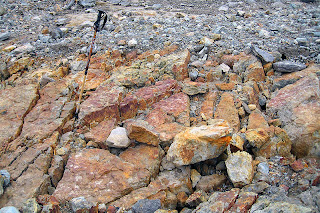How much do we know about Stonehenge? Less than we think. And what has Stonehenge got to do with the Ice Age? More than we might think. This blog is mostly devoted to the problems of where the Stonehenge bluestones came from, and how they got from their source areas to the monument. Now and then I will muse on related Stonehenge topics which have an Ice Age dimension...
THE BOOK
Some of the ideas discussed in this blog are published in my new book called "The Stonehenge Bluestones" -- available by post and through good bookshops everywhere. Bad bookshops might not have it....
To order, click HERE
Some of the ideas discussed in this blog are published in my new book called "The Stonehenge Bluestones" -- available by post and through good bookshops everywhere. Bad bookshops might not have it....
To order, click HERE
Friday, 28 October 2011
Super erratics and erratic clusters
I came across this on the fantastic "Glaciers Online" site, organized by Swiss Education. This is the famous "super erratic" at Bremgarten in Switzerland. Notice that it's in four large pieces -- so as in the case of the Big Rock at Okotoks in Canada, we have in effect a "giant erratic cluster."
http://www.swisseduc.ch/glaciers/index-en.html
If you look further on the Glaciers Online site there are many other spectacular photos of erratic clusters, like this one on Svalbard:
These are granite erratics that appear to have been transported as a group from a long way off -- reminiscent of the Darwin Boulders in Patagonia.
Here's an even more quirky occurrence from Broggerbreen in Svalbard -- a rectangulat piece of granite that looks for all the world as if a stonemason has been hard at work on it!
How are erratics like this entrained? Well, there appear to be two (at least!) prerequisites: high stresses on the glacier bed, creating fractures which weaken the coherence of the rock and permit quarrying to take place; and then freezing-on at the bed, with large stones picked up and carried off downglacier. Here is a rock surface (again in Svalbard) that has been broken up by subglacial processes and "prepared" for exploitation:
Some blocks have already been dragged away.
I remain convinced that in the right circumstances extremely large masses of bedrock can be dragged away by overriding ice and transported for hundreds of kilometres within a glacier.....
Subscribe to:
Post Comments (Atom)




No comments:
Post a Comment